- Home
- Anthony Ryan
A Duel of Evils
A Duel of Evils Read online
A Duel of Evils
A Raven’s Shadow Short Story
by
Anthony Ryan
Copyright Anthony Ryan 2014
Table of Contents
A Duel of Evils
About the Author
A Duel of Evils
- or -
The Fall of Kethia
Being a true and unbiased account of the destruction of that city compiled at the order of Emperor Aluran Maxtor Selsus (blessed by the Gods for all the ages) by Lord Verniers Alishe Someren, Imperial Chronicler and First of the Learned.
In preparing this history I have been honoured to follow My Emperor’s wise instruction to compose an account free from the vagaries of myth and legend, those cursed twins destined to forever obstruct the path of the rational scholar in his quest for truth. However, as you will see, all surviving sources relating to the events described below are riven, one might say sullied, by references to the bizarre and outright impossible. It is a singular mystery why an event of such import to the Volarian Empire, a culture renowned for promoting rationality with a vigour bordering on mania, should produce witnesses so lacking in that very quality. It is, of course, probable that these witnesses were delusional, the extremes of war having been known to strip reason from even the most stable mind. However, I have chosen not to exclude their more outlandish reportage, as it has ever been my contention that the perception of an event is at least as important as its true substance.
In considering how and why the once mighty city-state of Kethia came to its dreadful end, we must first understand its origins. The bulk of early Volarian history exists as a melange of legend and folklore, largely revolving around the deeds of various improbably mighty heroes, their myriad battles and betrayals performed in service to the now extinct Volarian pantheon. Much of the physical evidence to emerge from this period is limited to indecipherable tablet inscriptions and somewhat lurid illustrations from the few artifacts to survive, mostly pottery fragments and incomplete mosaics. The one unifying theme to these disparate images is that of destruction; cities burn, hordes of people are put to the sword by inhuman armies clad in blood-red armour, and beasts of unlikely configuration spring from the bowels of the earth to wreak all manner of havoc. Whilst these images are most certainly exaggerations or complete inventions, taken as a whole they do indicate that the landmass which now comprises the bulk of the Volarian Empire was once witness to a struggle of near genocidal proportions, a struggle that can only be said to have abated when recognisable settlements begin to reappear, generating trade and correspondence in the process.
The earliest reference to employ the modern name for Kethia dates back some sixteen hundred years, a full century in fact before the birth of our own (glorious and surely eternal) Empire. My prolonged sojourn through the imperial archives unearthed several ancient cargo manifests relating to the purchase and exchange of goods with a settlement situated on the western coast of what is now the Volarian province of Eskethia. The record of trade with this settlement increases in volume over successive centuries to the point where they attain sufficient wealth and sophistication to secure a formal treaty with Emperor Rahlun, the tenth chosen to sit on the Alpiran throne. The details of the treaty are fairly standard; an agreement to maintain existing tariffs and mutual protection of vessels from piracy. But it is clear from the preamble that by this point the Kethians were already engaged in a bitter rivalry with the port of Volar, situated over three hundred miles to the northeast.
A brief glance at any map of the north Volarian coast provides ample explanation as to why these two cities might come into conflict. Volar sits at the end of a long, narrow estuary known as the Cut of Lokar. A relatively easy waterway to navigate according to my seafaring sources, but providing markedly less ease of access to the Boraelin trade routes than that offered by Kethia, which also benefited from rich surrounding farmlands producing wine and cotton in substantial quantities. The decades preceding the Kethian treaty with Alpira had seen numerous border skirmishes and at least one major battle as the two ports competed for trade and prestige. However, events were to take a decidedly more serious turn with the advent of Volarian hegemony over much of the continent, a period known to history as The Forging Age. Aided by a sophisticated military doctrine, and a ruthlessly practical approach to both diplomacy and warfare, the nascent Volarian Empire had become a recognisable entity some eight centuries ago, at which point our tale begins in earnest.
To understand the subsequent course of events requires a certain appreciation of both the differences and similarities between Kethian and Volarian culture. It is not my intention to laud one as superior to the other, as it will become clear to My Emperor that both peoples appear somewhat bestial in comparison to the unmatched excellence of Alpiran society. For example, each culture employed a code of justice that can only be described as barbaric; every crime, regardless of pettiness, was (and remains so in modern Volaria) punishable by execution, more serious criminals being required to undergo a series of prescribed tortures before receiving the, no doubt, blessed release of death. However, similar brutality between the two adversaries was not matched by similar governance. I will spare you, Sire, a recounting of the long and ugly history of the peculiar Volarian institution of slavery, except to relate that by the dawn of its ascendancy, slavery sat at the heart of all aspects of Volarian society.
Volaria, as My Emperor knows, is ruled by a council drawn from the wealthiest citizens in the empire. In modern times the path to Council-man status is a mysterious one, wreathed in labyrinthine intrigue and a complex system of patronage. In fact, it is never clear to outsiders who sits on the council, as it appears some families have occupied their seats for generations without troubling themselves to change the name to match the current occupant. But, in its earlier incarnation entry to the council was simply a matter of amassing wealth equivalent to the value of one hundred thousand slaves. The number of council seats throughout the ages is therefore a useful indicator of the overall size of the empire, or at least its slave population. By the advent of unrestricted war against Kethia, the council consisted of ten members and its control over the growing Volarian dominions was near absolute.
Kethia, by contrast, had no need of councils. For, like the savages inhabiting the damp land to the north, Kethia had a king. However, unlike the north-men, the king of Kethia did not ascend by virtue of birth but at the whim of his people. Every four years all men over the age of thirty, owning house or livestock, would gather at an impressive structure in the city’s centre. The name of this building has been lost but, if the illustrations of Kethia’s ruins are to be believed, it would have been a remarkable sight, standing thirty feet tall and ringed by marble columns some five feet in diameter. Every man would be given a single black stone and a vase would be placed before each of the candidates aspiring to kingship. Each man would come forward and reach his hand into every vase, keeping his fist closed when he drew it out, so none would know into which vase he had dropped his stone. Once all the gathered men had cast their stones, each vase would be emptied and the stones counted in full view of the assembly. The candidate whose vase contained the most stones would ascend to the throne.
Any man of suitable age and property could present himself for kingship, though the Kethian scholar and diplomat Karvalev provides an insight into the kind of individual who stood the best chance of success:
No farmer ever won the throne. Nor a drover, nor a smith, nor a wheelwright. Our kings have ever been merchants, or the sons of merchants. Or warriors of great renown, or the sons of warriors of great renown. And none have ever known poverty. Kethian mothers wishing to shame indolent sons will often resort to an old saying, ‘Keep on like this and there’ll nev
er be a stone in your vase.’
Karvalev was fated, or cursed, to witness much of what follows, so naturally his account forms a principal source for this history. Many of his works have been lost to the ages but he appears to have been widely read in his lifetime, ensuring a considerable portion of his writings were copied and distributed, apparently to his great annoyance: ‘The whole world benefits from the art of this poor scholar who must bargain for ink.’
Volarian sources for this period are sparse and those that survive often biased to the point of uselessness, except to illustrate the depth of hatred many felt towards Kethia. They are thieves, one Volarian merchant wrote to a trading partner in far off Verehl. Every chance for profit is stolen by guile and graft. A Kethian will sell at a loss if it means denying profit to a Volarian.
However, it is Karvalev who provides the clearest illustration of Volarian antipathy to their wealthy neighbours at this time. The author of several fruitless missions to Volar in search of some form of peaceful accommodation, his final attempt produced this enlightening account of a brief meeting with an unnamed Council-man:
He stood regarding me with eyes of ice and face of stone, clad in robes of red silk and flanked on either side by guards with drawn swords. His every aspect seemed to convey the sense of a man suffering the worst indignity. Intent on my mission, I began to relate my message whereupon he spoke: ‘The dagger-tooth does not bargain with the goat.’
Karvalev goes on to describe being seized by the Council-man’s guards and marched back to his ship, his every step assailed by a baying mob crammed into the streets to spit their bile at the hated Kethian. Clearly, war with Volaria was becoming inevitable.
It should not be surmised, however, that trade was the only cause for antagonism between these rivals. Whilst they spoke much the same language and shared the same pantheon of gods, they pursued wildly differing modes of worship. As My Emperor will no doubt recall from my earlier treatise, The Land of Nightmares—A Portrait of Pre-Imperial Volaria, the long-vanished Volarian pantheon remains one of the most aggravating points of inquiry for the modern scholar, for only the priesthood were permitted to know the names of the gods. The common worshipper would look to the heroes of legend, quasi-godlike figures themselves, for inspiration and guidance, but direct appeals for divine intervention required the assistance of the priesthood, on payment of an offering of suitable value. Kethia, however, stood alone among the cultures to share this pantheon in having divested itself of a priesthood a century before its destruction. The Kethians, it is said, had committed the ultimate blasphemy in actually naming the gods and allowing any citizen, even women, to appeal to them directly. It is unsurprising, therefore, that the loudest Volarian voices to call for war came from the priesthood.
One of the few Volarian sources to offer a remotely unbiased account of the war comes from one Sevarik Entril, a junior officer at the war’s commencement, set to rise to battalion commander by its end. Entril wrote a series of letters to his wife throughout the conflict, unwittingly providing a valuable narrative of the campaign. It seems he entrusted these missives to a neutral sea captain who was in fact a spy in Alpiran service, hence the presence of copies in the Imperial Archives. Entril records his entire division being paraded at the base of one of the tall towers common to the long since destroyed Volarian temple complexes:
A priest stood atop the tower, calling out in the language of the gods, his words translated by one of his brothers who stood before us. His brother had been blessed, he told us, by a vision from not one, but every god in the heavens: ‘Kethia will tumble in flame and Volaria rise on its ashes!’ As was custom the priest then cast himself from the tower, his life’s work being complete and the gods sure to catch his soul as he fell. We raised our swords and cheered ourselves hoarse as his empty body shattered on the ground in bloody homage.
An additional point of particular odium to the Volarians was the Kethian practice of child sacrifice. As already noted, these cultures were evenly matched in their barbarity but this facet of Kethian society does make it difficult to express much sympathy for their eventual fate. That such a practice took place, and is not a figment of Volarian prejudice, is confirmed by Karvalev and several other contemporary sources. It appears sacrifices occurred only on the ascension of a new king, Karvalev’s account of one ceremony conveying a chilling sense of normalcy:
As the king took his throne he reached into a great glass bowl filled with wooden pegs onto which the name of every child in Kethia had been inscribed. No child was excluded, regardless of station, for what parent could forgo such an honour? Having chosen, the king stood and called out the name of the blessed child. On this occasion it was a boy of perhaps eight years, the son of a shipwright who proudly carried him forward, the boy bouncing on his father’s shoulders, laughing happily. The king greeted the boy with a kiss to the forehead before leading him, knife in hand, to the font from which the gods would drink come the moon-rise. The gods have ever blessed us, but they are also ever hungry.
It was the ascension of this particular king that provided the spark to war, for this king was a warrior, known to history as Tavurek and described by Karvalev as the apex of Kethia. His stature and prowess in battle matched by a mind keener than the sharpest blade. It seemed as if the gods saw our need and sent Tavurek from a prior age, for he was not made as other men. The Volarians were very thorough in destroying all images and statues of Tavurek, so the accuracy of Karvalev’s description cannot be judged, although Entril’s portrait of the doomed warrior king is in broad agreement with most Volarian sources:
He towered over his men as they advanced on us, unhelmed and arms bared, wielding a great two-bladed axe as if it weighed no more than a twig. A fury of muscle and steel, inspiring those that followed him to unhesitant sacrifice.
We know little of Tavurek’s early life, though Karvalev intimates he was born to a wealthy trading family and spent much of his boyhood at sea. There are various garish and frankly absurd legends surrounding Tavurek’s seafaring days, from abduction and seduction at the hands of exotic island queens, to savage battles with pirates where it’s said he learned his deadly skills. Surely the most outlandish of these fables is the future king’s epic battle with a giant, many-tentacled monstrosity from the ocean depths. Naturally, he emerged the victor but with wounds so severe he lay near death for several days. Whatever the truth of these tales, it is clear that by the time Tavurek rose to prominence he was both widely travelled and physically formidable. To the Kethians, however, his most important virtue was not his martial prowess but his passionate hatred of the Volarians.
Karvalev has left us a record of Tavurek’s first public address to the Kethian populace. Allowing for some poetic phrasing which can almost certainly be ascribed to the scholar’s hand, the speech provides an unambiguous insight into Tavurek’s virulent anti-Volarian stance:
Can they even be called men? These beasts, these curs, these wretches? Where is their honour, I ask you? Where is their courage? Where is their religion? They call us blasphemers. They say we dishonour the gods whilst their every act is an abomination. There is more religion in my dog!
References to the gods abound in Tavurek’s speeches. A Kethian ambassador to Alpira named him as the most devout man ever to sit on the throne, and we can say with some certainty that the new king considered his mission to be a divine one. They have called to me, my friend, Karvalev has him saying one evening as they shared a sparse meal of berries and water, it being the custom for Kethian kings to live frugally. The gods . . . I have heard their voice, and they name me their instrument on earth. The Volarian filth must be wiped away.
This does, of course, raise the possibility that Tavurek may have been insane, or at least partly delusional. If so, it was a shared delusion, for his people never wavered in their support, even unto death.
The first serious clash came barely two months after Tavurek’s ascension to the throne when he led a fleet of warships directly into
the Cut of Lokar. The king’s express intention was to choke off Volarian commerce, weakening the city in advance of an invasion. This proved a wildly ambitious notion. It appears the Volarians may have had some forewarning of Tavurek’s intentions, for his fleet soon found itself attacked in front and rear. A Verehlan sailor was witness to the subsequent debacle and gave the following account to an Alpiran associate several months later:
It all happened at night and at first I thought the gods had set both sky and sea afire. I saw many men tumbling from burning ships, alight and screaming as the Volarian mangonels did their work, the fireballs falling like a fiery rain. The Cut is rich in white-nosed sharks, small but vicious buggers they are, like to swarm on you in packs. There was so much for them to feed on it seemed the sea was boiling. By morning the shore was thick with wrecks, some Volarian but mostly Kethian, and the sharks were still busy feeding.
Tavurek somehow managed to survive the calamity and return to Kethia with the remnants of his fleet. Oddly, for a king who had authored such a calamity he was greeted with universal acclaim and there is no record of any dissent among the Kethian populace. He has a way about him, Karvalev said of Tavurek in the aftermath of the disaster. A means of capturing the souls of all men. I have never truly understood it, but even I find no room for doubt in my heart. I have never been more certain; this man is meant to lead us.
After such naked aggression it was inevitable that the Volarian counterblow would be swift. Kethia was soon blockaded, the Volarian fleet forcing all ships to seek harbour elsewhere regardless of flag, even sinking a dozen neutral vessels when their captains proved deaf to intimidation. However, the main blow would be delivered by land rather than sea. There are various estimates of the size of the Volarian army that marched into Kethian territory barely three months later, from Karvalev’s surely exaggerated half a million to Entril’s more restrained but still barely credible two hundred thousand. However, it was surely a formidable force, possibly the largest army to take the field during the Forging Age, and certainly the most experienced.

 Raven’s Shadow Book One: Blood Song (Raven's Shadow)
Raven’s Shadow Book One: Blood Song (Raven's Shadow)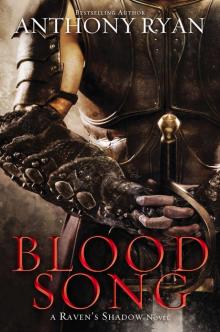 Blood Song
Blood Song Queen of Fire
Queen of Fire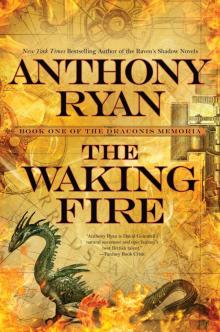 The Waking Fire
The Waking Fire The Legion of Flame
The Legion of Flame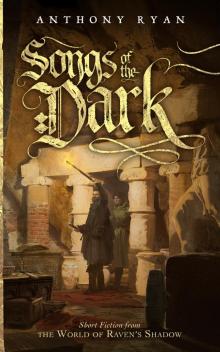 Songs of the Dark
Songs of the Dark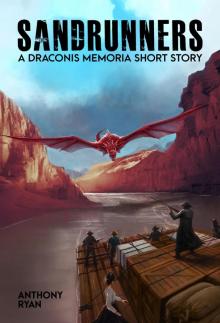 Sandrunners--A Draconis Memoria Short Story
Sandrunners--A Draconis Memoria Short Story Slab City Blues
Slab City Blues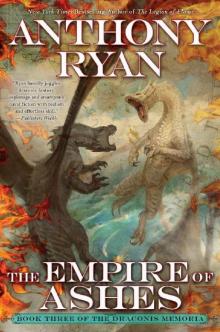 The Empire of Ashes
The Empire of Ashes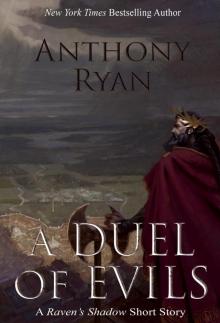 A Duel of Evils
A Duel of Evils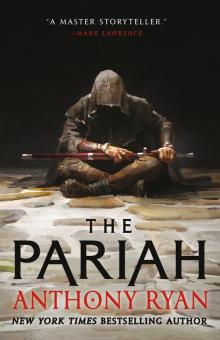 The Pariah
The Pariah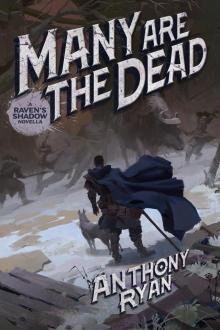 Many Are the Dead
Many Are the Dead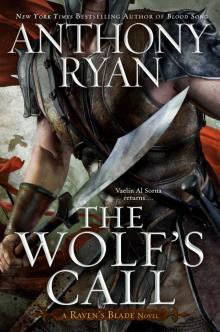 The Wolf's Call
The Wolf's Call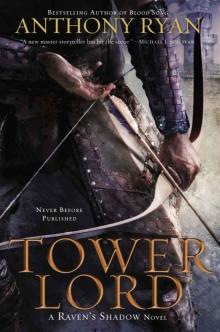 Tower Lord (A Raven's Shadow Novel)
Tower Lord (A Raven's Shadow Novel)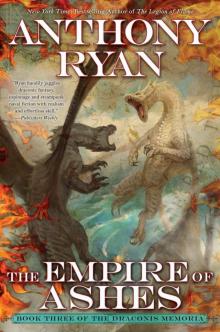 The Empire of Ashes (The Draconis Memoria)
The Empire of Ashes (The Draconis Memoria)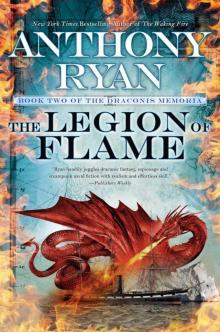 The Legion of Flame (The Draconis Memoria)
The Legion of Flame (The Draconis Memoria) Slab City Blues: A Song for Madame Choi
Slab City Blues: A Song for Madame Choi